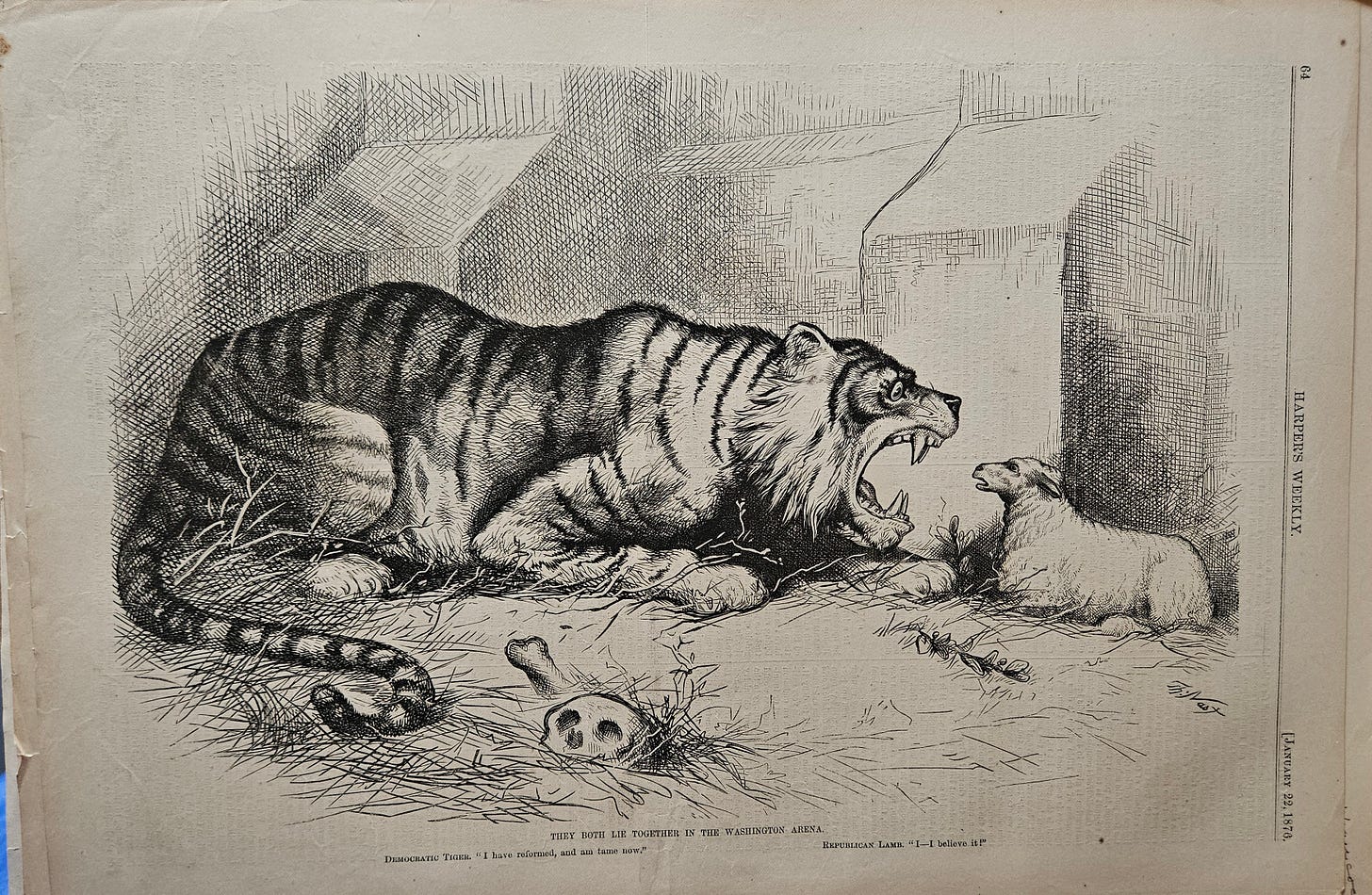'TIGER & LAMB,' --drawng by Thomas Nast, January 22, 1876. "THEY BOTH LIE TOGETHER IN THE WASHINGTON AREA." Democratic Tiger “I have reformed, and am tame now” Republican Lamb “I - I believe you.”
Interior Page woodblock cartoon, of that Harper's Weekly issue, Titled: "THEY BOTH LIE TOGETHER IN THE WASHINGTON AREA./DEMOCRATIC TIGER: "I HAVE REFORMED, AND AM TAME NOW." REPUBLICAN LAMB: "I--I BELIEVE IT!" with a strong Anti Democratic-Party content. 1876 was a presidential election year, which would end in the disputed Hayes-Tilden election struggle. Tilden the Democrat, should have won the election, but electoral votes from the former Confederate States were disputed---shades of the hanging chad---and in a political deal agreed to by both parties, Rutherford B. Hayes got the votes in return for withdrawing remaining Union troops from those states & thereby ending Reconstruction government.
According to his biographer, Fiona Deans Halloran, Nast was "intensely opposed to the encroachment of Catholic ideas into public education". Among his notable works were the creation of the modern version of Santa Claus----based on the traditional German figures of Sankt Nikolaus and Weihnachtsmann----and the political symbol of the elephant for the Republican Party. Contrary to popular belief, Nast did not create Uncle Sam----the male personification of the American people----or Columbia----the female personification of American values----or the Democratic donkey, though he did popularize these symbols through his artwork.
Nast was associated with the magazine Harper's Weekly from 1859 to 1860 and from 1862 until 1886. It has been argued by eminent historians that as a political cartoonist, Thomas Nast wielded more influence than any other artist of the 19th century.
He not only enthralled a vast audience with boldness and wit, but swayed it time and again to his personal position on the strength of his visual imagination. President Lincoln called Nast "our best recruiting sergeant" for one of his most celebrated cartoons "Compromise with the South", which was directed against those in the North who opposed the prosecution of the American Civil War, as well as, for drawing battlefields in border and southern states.
President Grant attributed his victory in 1868 to "the sword of Sheridan and the pencil of Thomas Nast."
In the 1872 presidential campaign, Nast's ridicule of Horace Greeley's candidacy was especially merciless. After Grant's victory in 1872, Mark Twain wrote the artist a letter saying: "Nast, you more than any other man have won a prodigious victory for Grant----I mean, rather, for Civilization and Progress."
As a crusading civil reformer he helped destroy the corrupt "Boss" Tweed Ring that swindled NYC of millions of dollars. His impact on American public life was formidable enough to profoundly affect he outcome of every presidential election during the period 1864 to 1884.
———-





Wow! Again, what a testament to Nast's influence! It's also interesting (to me) that given his resistance to religion, at least Catholicism, the image of "the Lion shall lie down with the Lamb" is Biblical. (He used a tiger.) And it sounds like he didn't think it was a good thing.